Analysis of Leadership, Training, and Talent Management in NHS HR
VerifiedAdded on 2021/01/02
|18
|4927
|151
Report
AI Summary
This report provides an in-depth analysis of people management within the National Health Service (NHS). It explores three key areas: leadership and management, training and development, and talent management. The leadership section examines various models, including the autocratic model, classical management theory, and trait theory, with applications to the NHS context. The training and development section highlights the importance of these programs in improving employee performance, satisfaction, and morale, as well as addressing weaknesses and increasing company reputation. Finally, the talent management section discusses the AARRR model for employee revenue and candidate selection. The report emphasizes the significance of effective HR practices in enhancing productivity, employee engagement, and overall organizational success within the NHS, considering both internal and external factors that influence these areas.
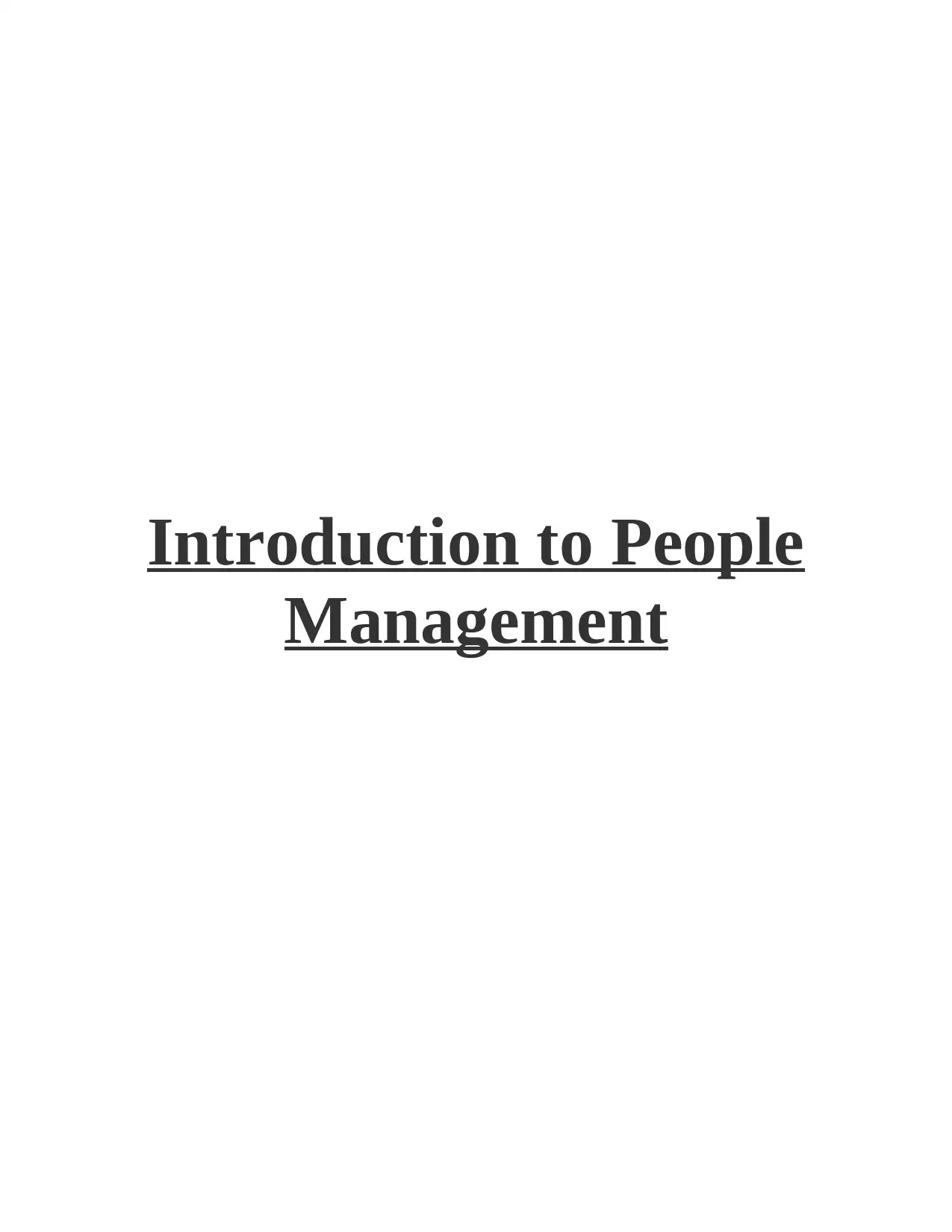
Introduction to People
Management
Management
Paraphrase This Document
Need a fresh take? Get an instant paraphrase of this document with our AI Paraphraser
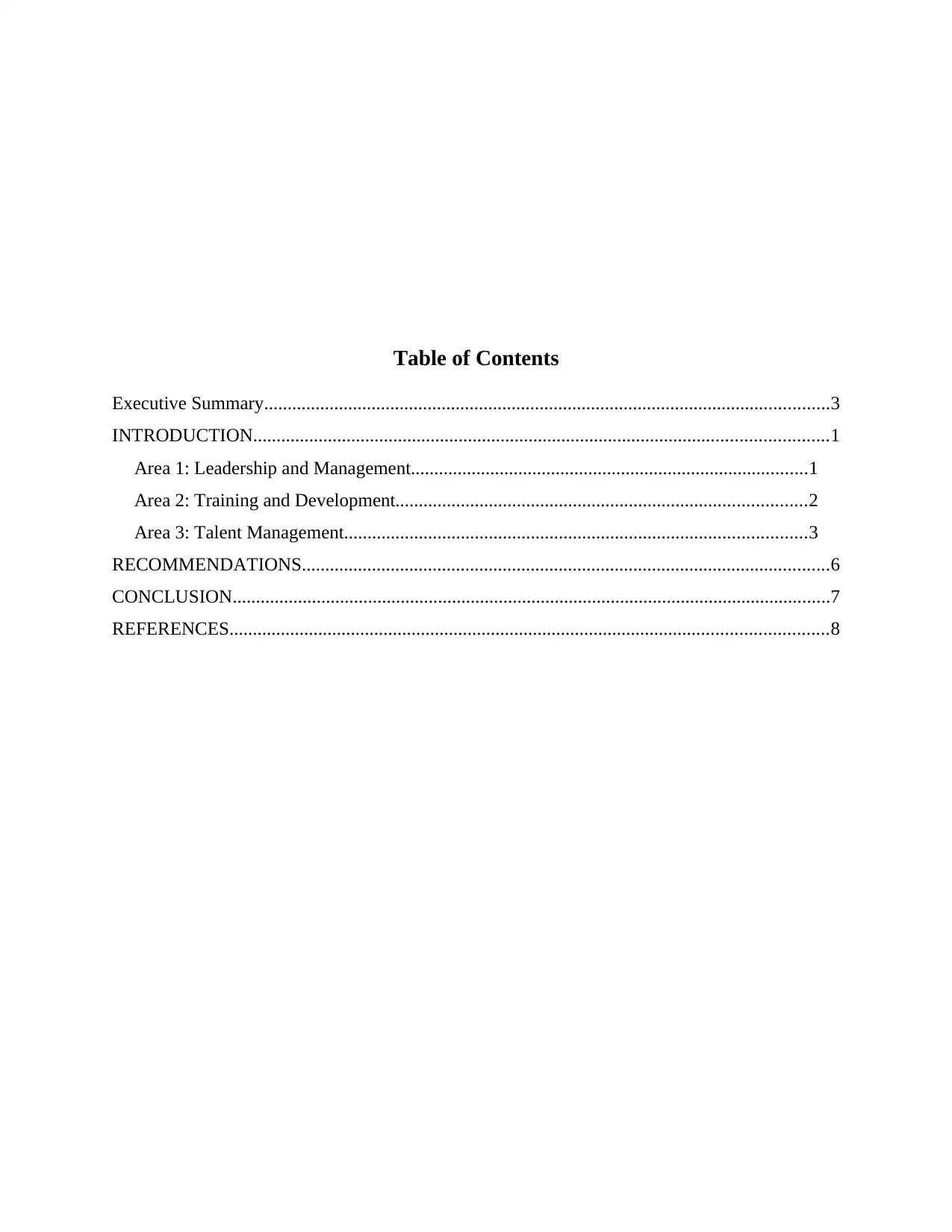
Table of Contents
Executive Summary.........................................................................................................................3
INTRODUCTION...........................................................................................................................1
Area 1: Leadership and Management.....................................................................................1
Area 2: Training and Development........................................................................................2
Area 3: Talent Management...................................................................................................3
RECOMMENDATIONS.................................................................................................................6
CONCLUSION................................................................................................................................7
REFERENCES................................................................................................................................8
Executive Summary.........................................................................................................................3
INTRODUCTION...........................................................................................................................1
Area 1: Leadership and Management.....................................................................................1
Area 2: Training and Development........................................................................................2
Area 3: Talent Management...................................................................................................3
RECOMMENDATIONS.................................................................................................................6
CONCLUSION................................................................................................................................7
REFERENCES................................................................................................................................8
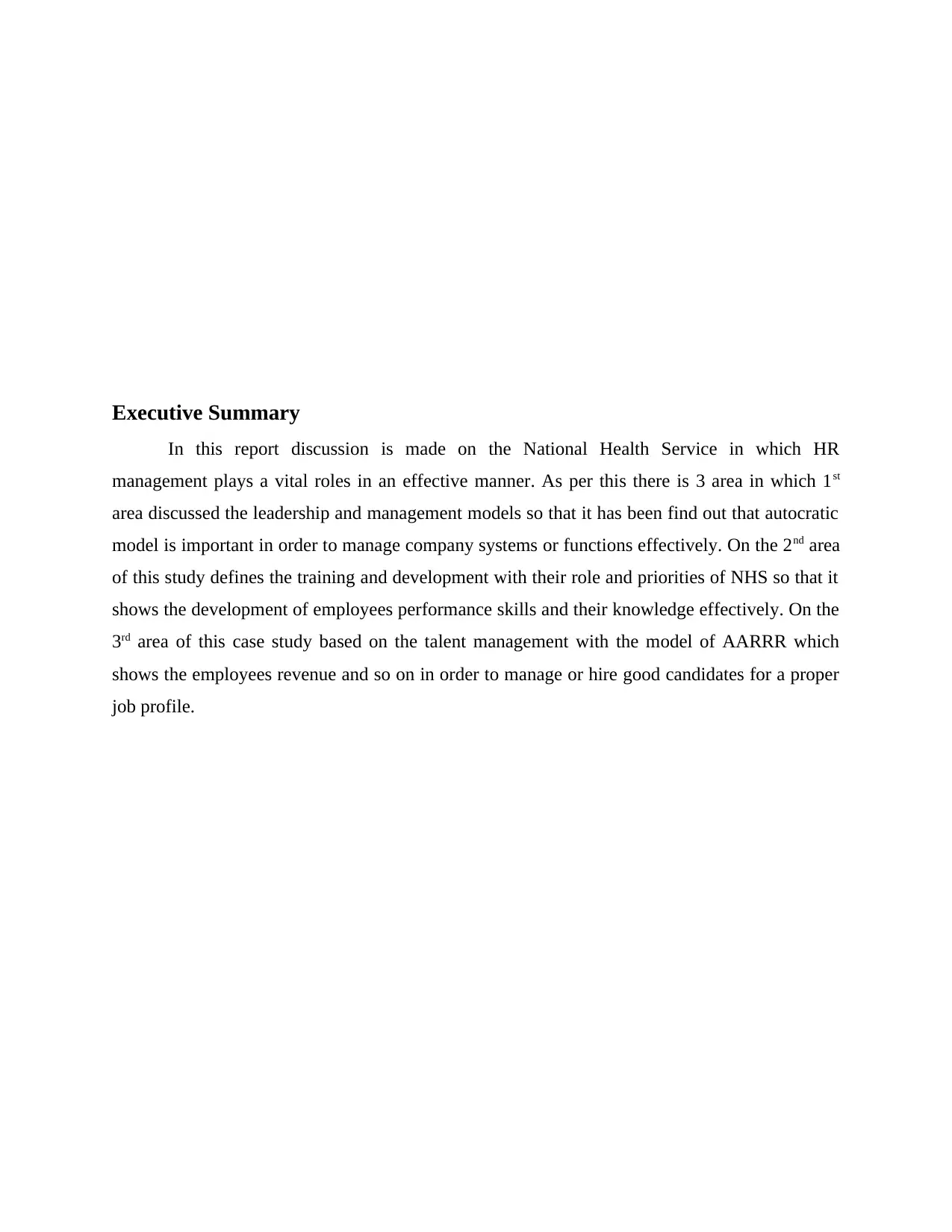
Executive Summary
In this report discussion is made on the National Health Service in which HR
management plays a vital roles in an effective manner. As per this there is 3 area in which 1st
area discussed the leadership and management models so that it has been find out that autocratic
model is important in order to manage company systems or functions effectively. On the 2nd area
of this study defines the training and development with their role and priorities of NHS so that it
shows the development of employees performance skills and their knowledge effectively. On the
3rd area of this case study based on the talent management with the model of AARRR which
shows the employees revenue and so on in order to manage or hire good candidates for a proper
job profile.
In this report discussion is made on the National Health Service in which HR
management plays a vital roles in an effective manner. As per this there is 3 area in which 1st
area discussed the leadership and management models so that it has been find out that autocratic
model is important in order to manage company systems or functions effectively. On the 2nd area
of this study defines the training and development with their role and priorities of NHS so that it
shows the development of employees performance skills and their knowledge effectively. On the
3rd area of this case study based on the talent management with the model of AARRR which
shows the employees revenue and so on in order to manage or hire good candidates for a proper
job profile.
⊘ This is a preview!⊘
Do you want full access?
Subscribe today to unlock all pages.

Trusted by 1+ million students worldwide
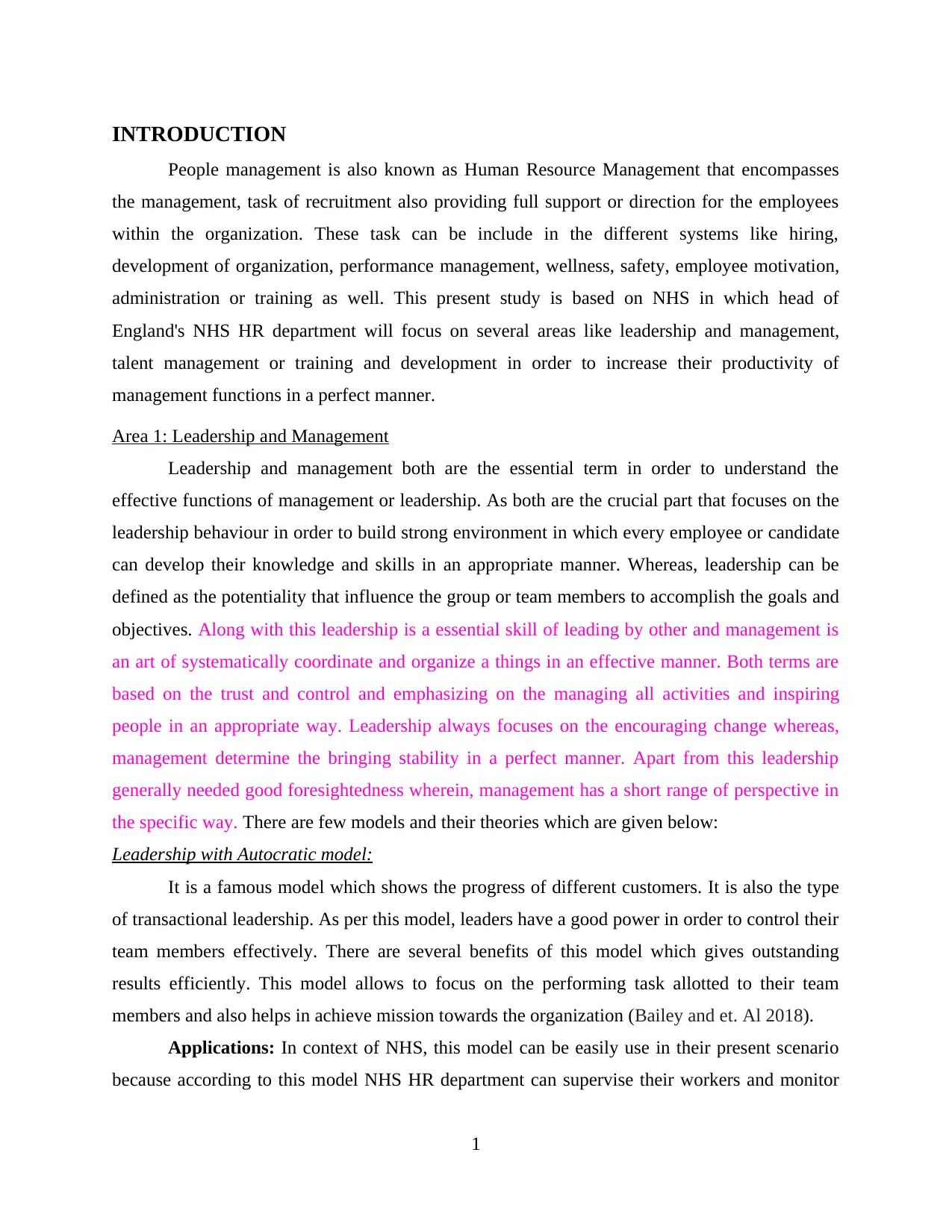
INTRODUCTION
People management is also known as Human Resource Management that encompasses
the management, task of recruitment also providing full support or direction for the employees
within the organization. These task can be include in the different systems like hiring,
development of organization, performance management, wellness, safety, employee motivation,
administration or training as well. This present study is based on NHS in which head of
England's NHS HR department will focus on several areas like leadership and management,
talent management or training and development in order to increase their productivity of
management functions in a perfect manner.
Area 1: Leadership and Management
Leadership and management both are the essential term in order to understand the
effective functions of management or leadership. As both are the crucial part that focuses on the
leadership behaviour in order to build strong environment in which every employee or candidate
can develop their knowledge and skills in an appropriate manner. Whereas, leadership can be
defined as the potentiality that influence the group or team members to accomplish the goals and
objectives. Along with this leadership is a essential skill of leading by other and management is
an art of systematically coordinate and organize a things in an effective manner. Both terms are
based on the trust and control and emphasizing on the managing all activities and inspiring
people in an appropriate way. Leadership always focuses on the encouraging change whereas,
management determine the bringing stability in a perfect manner. Apart from this leadership
generally needed good foresightedness wherein, management has a short range of perspective in
the specific way. There are few models and their theories which are given below:
Leadership with Autocratic model:
It is a famous model which shows the progress of different customers. It is also the type
of transactional leadership. As per this model, leaders have a good power in order to control their
team members effectively. There are several benefits of this model which gives outstanding
results efficiently. This model allows to focus on the performing task allotted to their team
members and also helps in achieve mission towards the organization (Bailey and et. Al 2018).
Applications: In context of NHS, this model can be easily use in their present scenario
because according to this model NHS HR department can supervise their workers and monitor
1
People management is also known as Human Resource Management that encompasses
the management, task of recruitment also providing full support or direction for the employees
within the organization. These task can be include in the different systems like hiring,
development of organization, performance management, wellness, safety, employee motivation,
administration or training as well. This present study is based on NHS in which head of
England's NHS HR department will focus on several areas like leadership and management,
talent management or training and development in order to increase their productivity of
management functions in a perfect manner.
Area 1: Leadership and Management
Leadership and management both are the essential term in order to understand the
effective functions of management or leadership. As both are the crucial part that focuses on the
leadership behaviour in order to build strong environment in which every employee or candidate
can develop their knowledge and skills in an appropriate manner. Whereas, leadership can be
defined as the potentiality that influence the group or team members to accomplish the goals and
objectives. Along with this leadership is a essential skill of leading by other and management is
an art of systematically coordinate and organize a things in an effective manner. Both terms are
based on the trust and control and emphasizing on the managing all activities and inspiring
people in an appropriate way. Leadership always focuses on the encouraging change whereas,
management determine the bringing stability in a perfect manner. Apart from this leadership
generally needed good foresightedness wherein, management has a short range of perspective in
the specific way. There are few models and their theories which are given below:
Leadership with Autocratic model:
It is a famous model which shows the progress of different customers. It is also the type
of transactional leadership. As per this model, leaders have a good power in order to control their
team members effectively. There are several benefits of this model which gives outstanding
results efficiently. This model allows to focus on the performing task allotted to their team
members and also helps in achieve mission towards the organization (Bailey and et. Al 2018).
Applications: In context of NHS, this model can be easily use in their present scenario
because according to this model NHS HR department can supervise their workers and monitor
1
Paraphrase This Document
Need a fresh take? Get an instant paraphrase of this document with our AI Paraphraser

their activities efficiently it also ensures that workers has to complete their duties or task with in
the given period of time in order to increase productivity of the company in a better way. So that
this model influences National health services scenario in a specified manner.
Classical management theory:
This theory is based on the belief in which workers only have economic and physical
needs. It does not involves in social needs or job satisfaction but apart from this it includes in
specialization of labour, centralizes decision making or leadership as well as profit maximization
in an effective manner. This theory mainly emphasis on the structure, explanation about good
thing of firms and focuses on the practical managers effectively.
Applications: This theory is important for NHS present scenario by this company can
focus on their employees physical and social needs in order to satisfied their job effectively. This
thinking of the HR department can enhance the employees confidence towards their work.
Therefore it is essential for NHS so that they can maximise their performance easily.
Great Man theory:
As per this theory, leaders are born with all right traits and abilities to lead. The skills in a
leader are intellect, confidence, communication, and social skills. In other words, it is an inherent
trait of an individual who has all the skills to become a leader.
Applications: NHS can apply this theory to have more leaders possessing good skills and
who can motivate the employees top work efficiently. Furthermore, this can help others become
good leaders (Antonakis and House, 2013).
Trait theory:
This was given by Ralph M. Stogdill in which he defined that a person acting as leader
must have all the key personality traits and characteristics so that leadership can be applied
effectively. There is one more assumption that a leader have all these skills by birth.
Applications: This theory is useful in creating effective leaders who have all qualities of
becoming a leader. With the application of this theory, NHS can choose some leaders who have
the ability to become a leader. This will help in attaining the objectives by maintaining a co-
ordination between all team members.
Behavioural theory:
This theory mainly focuses on how a leader should behave with team members. It is
believed that a leader having appropriate traits is useless without the right behaviour. There must
2
the given period of time in order to increase productivity of the company in a better way. So that
this model influences National health services scenario in a specified manner.
Classical management theory:
This theory is based on the belief in which workers only have economic and physical
needs. It does not involves in social needs or job satisfaction but apart from this it includes in
specialization of labour, centralizes decision making or leadership as well as profit maximization
in an effective manner. This theory mainly emphasis on the structure, explanation about good
thing of firms and focuses on the practical managers effectively.
Applications: This theory is important for NHS present scenario by this company can
focus on their employees physical and social needs in order to satisfied their job effectively. This
thinking of the HR department can enhance the employees confidence towards their work.
Therefore it is essential for NHS so that they can maximise their performance easily.
Great Man theory:
As per this theory, leaders are born with all right traits and abilities to lead. The skills in a
leader are intellect, confidence, communication, and social skills. In other words, it is an inherent
trait of an individual who has all the skills to become a leader.
Applications: NHS can apply this theory to have more leaders possessing good skills and
who can motivate the employees top work efficiently. Furthermore, this can help others become
good leaders (Antonakis and House, 2013).
Trait theory:
This was given by Ralph M. Stogdill in which he defined that a person acting as leader
must have all the key personality traits and characteristics so that leadership can be applied
effectively. There is one more assumption that a leader have all these skills by birth.
Applications: This theory is useful in creating effective leaders who have all qualities of
becoming a leader. With the application of this theory, NHS can choose some leaders who have
the ability to become a leader. This will help in attaining the objectives by maintaining a co-
ordination between all team members.
Behavioural theory:
This theory mainly focuses on how a leader should behave with team members. It is
believed that a leader having appropriate traits is useless without the right behaviour. There must
2
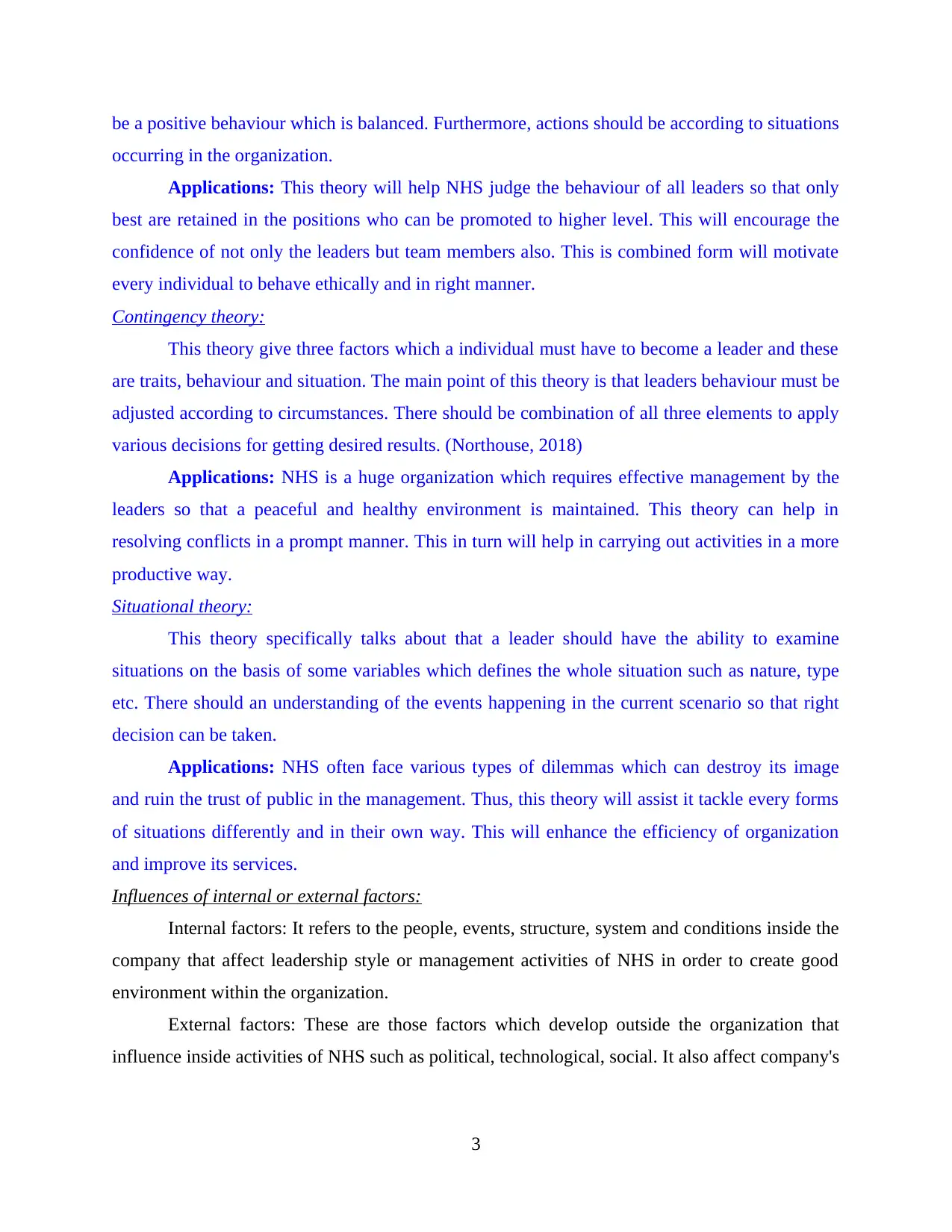
be a positive behaviour which is balanced. Furthermore, actions should be according to situations
occurring in the organization.
Applications: This theory will help NHS judge the behaviour of all leaders so that only
best are retained in the positions who can be promoted to higher level. This will encourage the
confidence of not only the leaders but team members also. This is combined form will motivate
every individual to behave ethically and in right manner.
Contingency theory:
This theory give three factors which a individual must have to become a leader and these
are traits, behaviour and situation. The main point of this theory is that leaders behaviour must be
adjusted according to circumstances. There should be combination of all three elements to apply
various decisions for getting desired results. (Northouse, 2018)
Applications: NHS is a huge organization which requires effective management by the
leaders so that a peaceful and healthy environment is maintained. This theory can help in
resolving conflicts in a prompt manner. This in turn will help in carrying out activities in a more
productive way.
Situational theory:
This theory specifically talks about that a leader should have the ability to examine
situations on the basis of some variables which defines the whole situation such as nature, type
etc. There should an understanding of the events happening in the current scenario so that right
decision can be taken.
Applications: NHS often face various types of dilemmas which can destroy its image
and ruin the trust of public in the management. Thus, this theory will assist it tackle every forms
of situations differently and in their own way. This will enhance the efficiency of organization
and improve its services.
Influences of internal or external factors:
Internal factors: It refers to the people, events, structure, system and conditions inside the
company that affect leadership style or management activities of NHS in order to create good
environment within the organization.
External factors: These are those factors which develop outside the organization that
influence inside activities of NHS such as political, technological, social. It also affect company's
3
occurring in the organization.
Applications: This theory will help NHS judge the behaviour of all leaders so that only
best are retained in the positions who can be promoted to higher level. This will encourage the
confidence of not only the leaders but team members also. This is combined form will motivate
every individual to behave ethically and in right manner.
Contingency theory:
This theory give three factors which a individual must have to become a leader and these
are traits, behaviour and situation. The main point of this theory is that leaders behaviour must be
adjusted according to circumstances. There should be combination of all three elements to apply
various decisions for getting desired results. (Northouse, 2018)
Applications: NHS is a huge organization which requires effective management by the
leaders so that a peaceful and healthy environment is maintained. This theory can help in
resolving conflicts in a prompt manner. This in turn will help in carrying out activities in a more
productive way.
Situational theory:
This theory specifically talks about that a leader should have the ability to examine
situations on the basis of some variables which defines the whole situation such as nature, type
etc. There should an understanding of the events happening in the current scenario so that right
decision can be taken.
Applications: NHS often face various types of dilemmas which can destroy its image
and ruin the trust of public in the management. Thus, this theory will assist it tackle every forms
of situations differently and in their own way. This will enhance the efficiency of organization
and improve its services.
Influences of internal or external factors:
Internal factors: It refers to the people, events, structure, system and conditions inside the
company that affect leadership style or management activities of NHS in order to create good
environment within the organization.
External factors: These are those factors which develop outside the organization that
influence inside activities of NHS such as political, technological, social. It also affect company's
3
⊘ This is a preview!⊘
Do you want full access?
Subscribe today to unlock all pages.

Trusted by 1+ million students worldwide
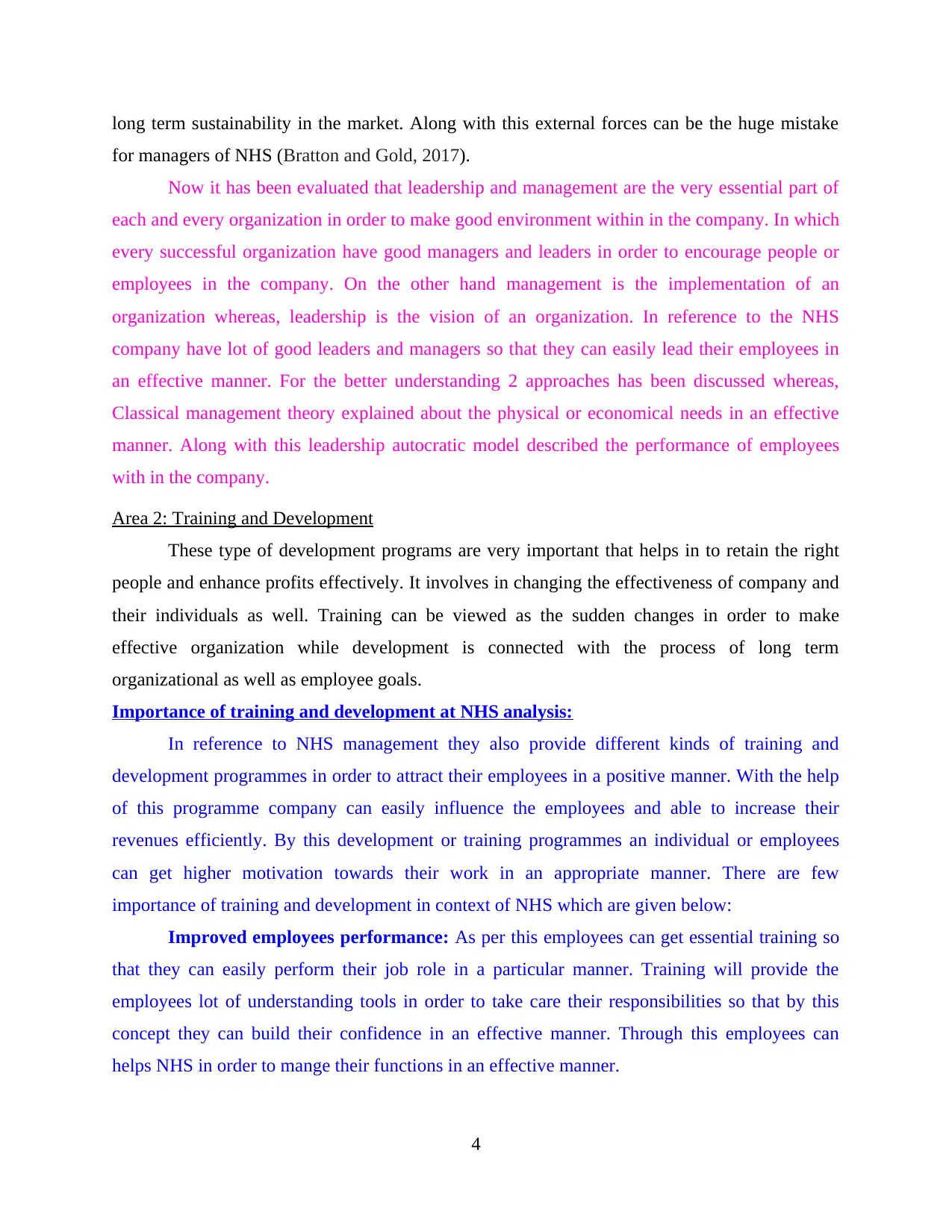
long term sustainability in the market. Along with this external forces can be the huge mistake
for managers of NHS (Bratton and Gold, 2017).
Now it has been evaluated that leadership and management are the very essential part of
each and every organization in order to make good environment within in the company. In which
every successful organization have good managers and leaders in order to encourage people or
employees in the company. On the other hand management is the implementation of an
organization whereas, leadership is the vision of an organization. In reference to the NHS
company have lot of good leaders and managers so that they can easily lead their employees in
an effective manner. For the better understanding 2 approaches has been discussed whereas,
Classical management theory explained about the physical or economical needs in an effective
manner. Along with this leadership autocratic model described the performance of employees
with in the company.
Area 2: Training and Development
These type of development programs are very important that helps in to retain the right
people and enhance profits effectively. It involves in changing the effectiveness of company and
their individuals as well. Training can be viewed as the sudden changes in order to make
effective organization while development is connected with the process of long term
organizational as well as employee goals.
Importance of training and development at NHS analysis:
In reference to NHS management they also provide different kinds of training and
development programmes in order to attract their employees in a positive manner. With the help
of this programme company can easily influence the employees and able to increase their
revenues efficiently. By this development or training programmes an individual or employees
can get higher motivation towards their work in an appropriate manner. There are few
importance of training and development in context of NHS which are given below:
Improved employees performance: As per this employees can get essential training so
that they can easily perform their job role in a particular manner. Training will provide the
employees lot of understanding tools in order to take care their responsibilities so that by this
concept they can build their confidence in an effective manner. Through this employees can
helps NHS in order to mange their functions in an effective manner.
4
for managers of NHS (Bratton and Gold, 2017).
Now it has been evaluated that leadership and management are the very essential part of
each and every organization in order to make good environment within in the company. In which
every successful organization have good managers and leaders in order to encourage people or
employees in the company. On the other hand management is the implementation of an
organization whereas, leadership is the vision of an organization. In reference to the NHS
company have lot of good leaders and managers so that they can easily lead their employees in
an effective manner. For the better understanding 2 approaches has been discussed whereas,
Classical management theory explained about the physical or economical needs in an effective
manner. Along with this leadership autocratic model described the performance of employees
with in the company.
Area 2: Training and Development
These type of development programs are very important that helps in to retain the right
people and enhance profits effectively. It involves in changing the effectiveness of company and
their individuals as well. Training can be viewed as the sudden changes in order to make
effective organization while development is connected with the process of long term
organizational as well as employee goals.
Importance of training and development at NHS analysis:
In reference to NHS management they also provide different kinds of training and
development programmes in order to attract their employees in a positive manner. With the help
of this programme company can easily influence the employees and able to increase their
revenues efficiently. By this development or training programmes an individual or employees
can get higher motivation towards their work in an appropriate manner. There are few
importance of training and development in context of NHS which are given below:
Improved employees performance: As per this employees can get essential training so
that they can easily perform their job role in a particular manner. Training will provide the
employees lot of understanding tools in order to take care their responsibilities so that by this
concept they can build their confidence in an effective manner. Through this employees can
helps NHS in order to mange their functions in an effective manner.
4
Paraphrase This Document
Need a fresh take? Get an instant paraphrase of this document with our AI Paraphraser
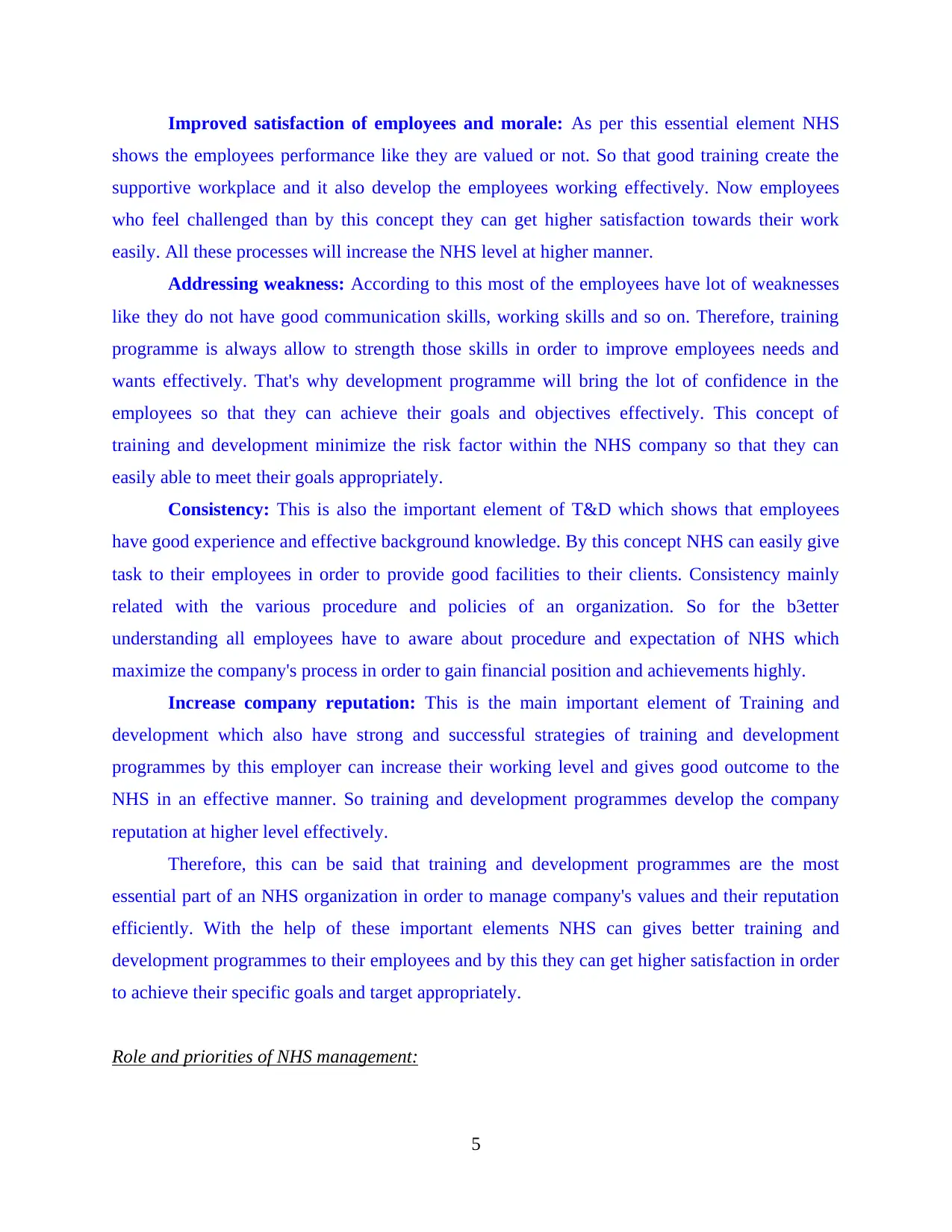
Improved satisfaction of employees and morale: As per this essential element NHS
shows the employees performance like they are valued or not. So that good training create the
supportive workplace and it also develop the employees working effectively. Now employees
who feel challenged than by this concept they can get higher satisfaction towards their work
easily. All these processes will increase the NHS level at higher manner.
Addressing weakness: According to this most of the employees have lot of weaknesses
like they do not have good communication skills, working skills and so on. Therefore, training
programme is always allow to strength those skills in order to improve employees needs and
wants effectively. That's why development programme will bring the lot of confidence in the
employees so that they can achieve their goals and objectives effectively. This concept of
training and development minimize the risk factor within the NHS company so that they can
easily able to meet their goals appropriately.
Consistency: This is also the important element of T&D which shows that employees
have good experience and effective background knowledge. By this concept NHS can easily give
task to their employees in order to provide good facilities to their clients. Consistency mainly
related with the various procedure and policies of an organization. So for the b3etter
understanding all employees have to aware about procedure and expectation of NHS which
maximize the company's process in order to gain financial position and achievements highly.
Increase company reputation: This is the main important element of Training and
development which also have strong and successful strategies of training and development
programmes by this employer can increase their working level and gives good outcome to the
NHS in an effective manner. So training and development programmes develop the company
reputation at higher level effectively.
Therefore, this can be said that training and development programmes are the most
essential part of an NHS organization in order to manage company's values and their reputation
efficiently. With the help of these important elements NHS can gives better training and
development programmes to their employees and by this they can get higher satisfaction in order
to achieve their specific goals and target appropriately.
Role and priorities of NHS management:
5
shows the employees performance like they are valued or not. So that good training create the
supportive workplace and it also develop the employees working effectively. Now employees
who feel challenged than by this concept they can get higher satisfaction towards their work
easily. All these processes will increase the NHS level at higher manner.
Addressing weakness: According to this most of the employees have lot of weaknesses
like they do not have good communication skills, working skills and so on. Therefore, training
programme is always allow to strength those skills in order to improve employees needs and
wants effectively. That's why development programme will bring the lot of confidence in the
employees so that they can achieve their goals and objectives effectively. This concept of
training and development minimize the risk factor within the NHS company so that they can
easily able to meet their goals appropriately.
Consistency: This is also the important element of T&D which shows that employees
have good experience and effective background knowledge. By this concept NHS can easily give
task to their employees in order to provide good facilities to their clients. Consistency mainly
related with the various procedure and policies of an organization. So for the b3etter
understanding all employees have to aware about procedure and expectation of NHS which
maximize the company's process in order to gain financial position and achievements highly.
Increase company reputation: This is the main important element of Training and
development which also have strong and successful strategies of training and development
programmes by this employer can increase their working level and gives good outcome to the
NHS in an effective manner. So training and development programmes develop the company
reputation at higher level effectively.
Therefore, this can be said that training and development programmes are the most
essential part of an NHS organization in order to manage company's values and their reputation
efficiently. With the help of these important elements NHS can gives better training and
development programmes to their employees and by this they can get higher satisfaction in order
to achieve their specific goals and target appropriately.
Role and priorities of NHS management:
5
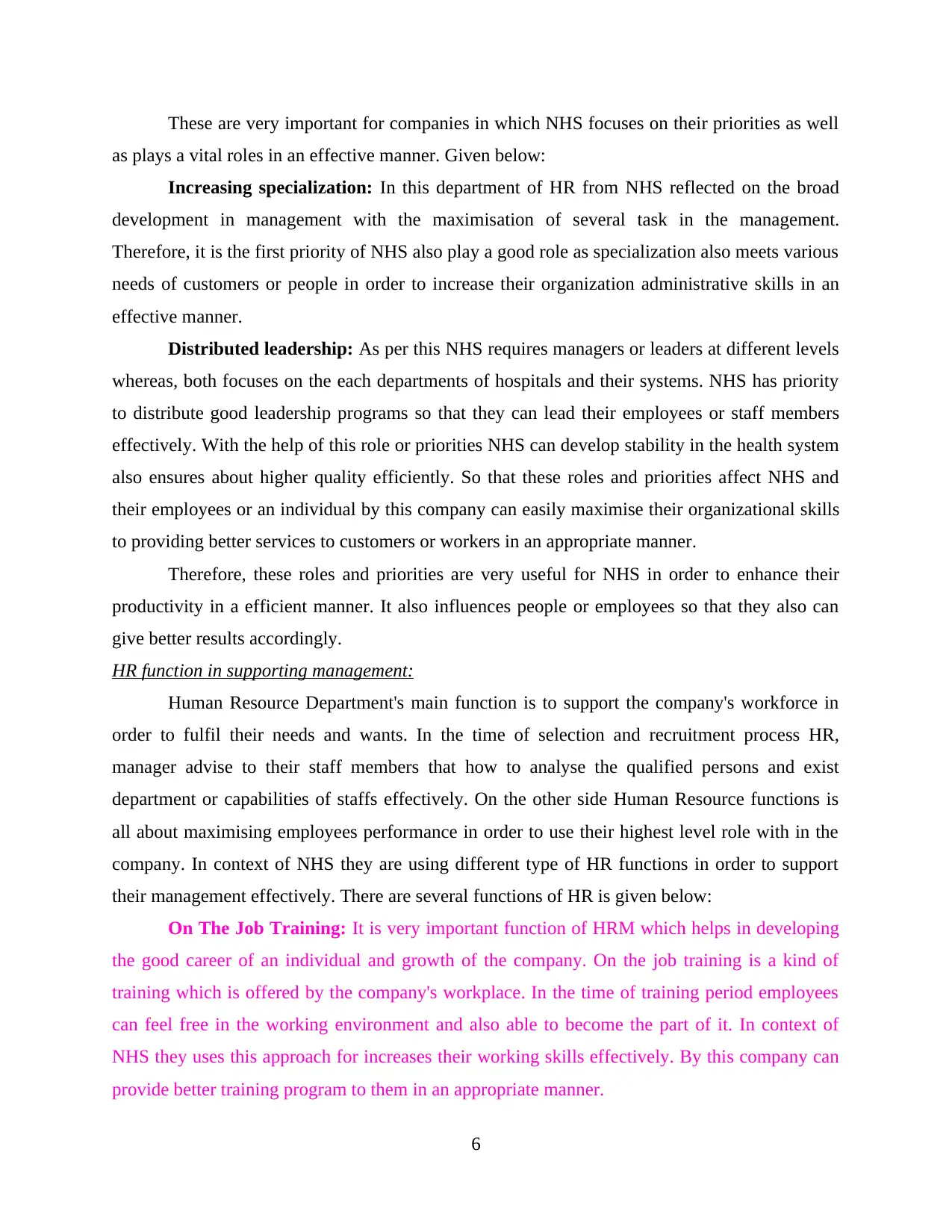
These are very important for companies in which NHS focuses on their priorities as well
as plays a vital roles in an effective manner. Given below:
Increasing specialization: In this department of HR from NHS reflected on the broad
development in management with the maximisation of several task in the management.
Therefore, it is the first priority of NHS also play a good role as specialization also meets various
needs of customers or people in order to increase their organization administrative skills in an
effective manner.
Distributed leadership: As per this NHS requires managers or leaders at different levels
whereas, both focuses on the each departments of hospitals and their systems. NHS has priority
to distribute good leadership programs so that they can lead their employees or staff members
effectively. With the help of this role or priorities NHS can develop stability in the health system
also ensures about higher quality efficiently. So that these roles and priorities affect NHS and
their employees or an individual by this company can easily maximise their organizational skills
to providing better services to customers or workers in an appropriate manner.
Therefore, these roles and priorities are very useful for NHS in order to enhance their
productivity in a efficient manner. It also influences people or employees so that they also can
give better results accordingly.
HR function in supporting management:
Human Resource Department's main function is to support the company's workforce in
order to fulfil their needs and wants. In the time of selection and recruitment process HR,
manager advise to their staff members that how to analyse the qualified persons and exist
department or capabilities of staffs effectively. On the other side Human Resource functions is
all about maximising employees performance in order to use their highest level role with in the
company. In context of NHS they are using different type of HR functions in order to support
their management effectively. There are several functions of HR is given below:
On The Job Training: It is very important function of HRM which helps in developing
the good career of an individual and growth of the company. On the job training is a kind of
training which is offered by the company's workplace. In the time of training period employees
can feel free in the working environment and also able to become the part of it. In context of
NHS they uses this approach for increases their working skills effectively. By this company can
provide better training program to them in an appropriate manner.
6
as plays a vital roles in an effective manner. Given below:
Increasing specialization: In this department of HR from NHS reflected on the broad
development in management with the maximisation of several task in the management.
Therefore, it is the first priority of NHS also play a good role as specialization also meets various
needs of customers or people in order to increase their organization administrative skills in an
effective manner.
Distributed leadership: As per this NHS requires managers or leaders at different levels
whereas, both focuses on the each departments of hospitals and their systems. NHS has priority
to distribute good leadership programs so that they can lead their employees or staff members
effectively. With the help of this role or priorities NHS can develop stability in the health system
also ensures about higher quality efficiently. So that these roles and priorities affect NHS and
their employees or an individual by this company can easily maximise their organizational skills
to providing better services to customers or workers in an appropriate manner.
Therefore, these roles and priorities are very useful for NHS in order to enhance their
productivity in a efficient manner. It also influences people or employees so that they also can
give better results accordingly.
HR function in supporting management:
Human Resource Department's main function is to support the company's workforce in
order to fulfil their needs and wants. In the time of selection and recruitment process HR,
manager advise to their staff members that how to analyse the qualified persons and exist
department or capabilities of staffs effectively. On the other side Human Resource functions is
all about maximising employees performance in order to use their highest level role with in the
company. In context of NHS they are using different type of HR functions in order to support
their management effectively. There are several functions of HR is given below:
On The Job Training: It is very important function of HRM which helps in developing
the good career of an individual and growth of the company. On the job training is a kind of
training which is offered by the company's workplace. In the time of training period employees
can feel free in the working environment and also able to become the part of it. In context of
NHS they uses this approach for increases their working skills effectively. By this company can
provide better training program to them in an appropriate manner.
6
⊘ This is a preview!⊘
Do you want full access?
Subscribe today to unlock all pages.

Trusted by 1+ million students worldwide
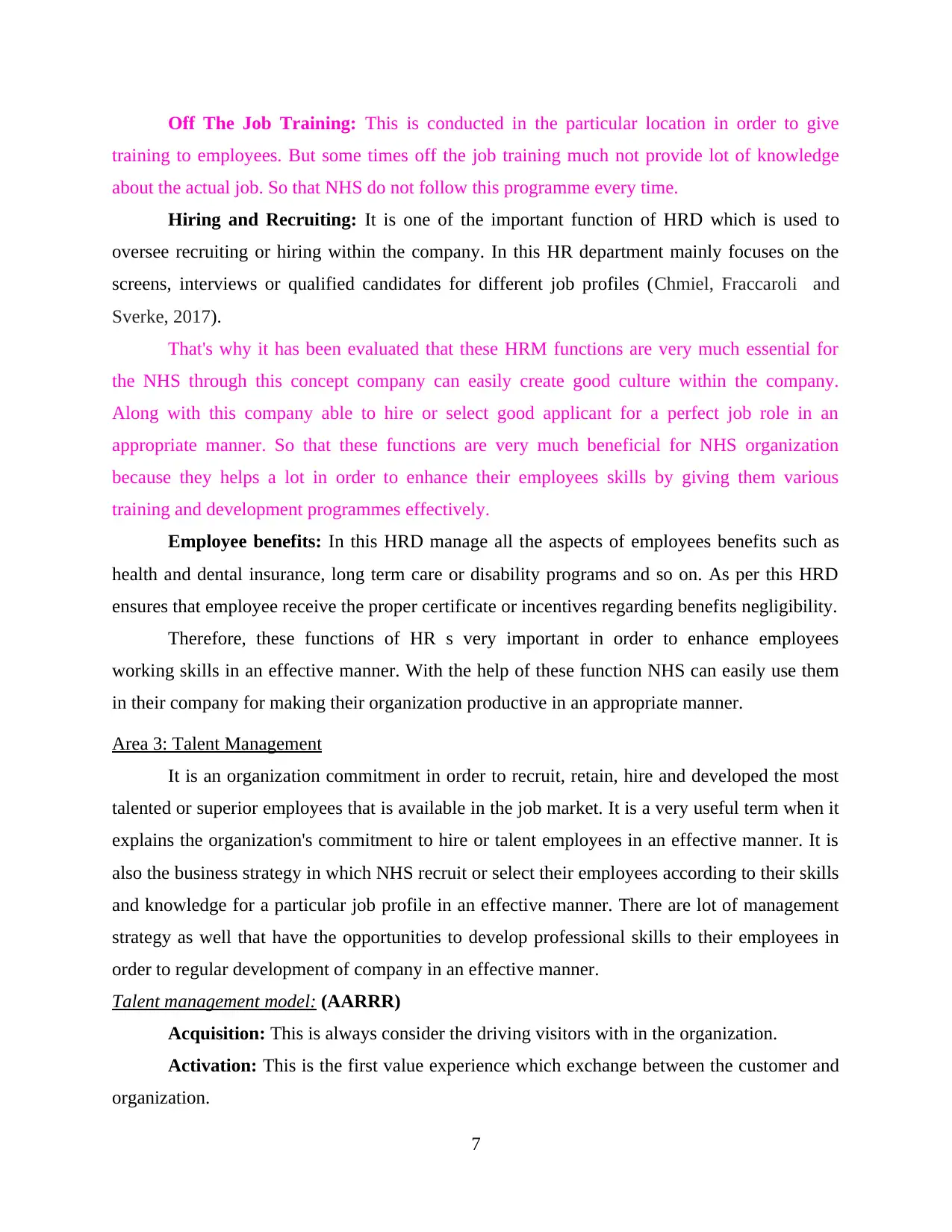
Off The Job Training: This is conducted in the particular location in order to give
training to employees. But some times off the job training much not provide lot of knowledge
about the actual job. So that NHS do not follow this programme every time.
Hiring and Recruiting: It is one of the important function of HRD which is used to
oversee recruiting or hiring within the company. In this HR department mainly focuses on the
screens, interviews or qualified candidates for different job profiles (Chmiel, Fraccaroli and
Sverke, 2017).
That's why it has been evaluated that these HRM functions are very much essential for
the NHS through this concept company can easily create good culture within the company.
Along with this company able to hire or select good applicant for a perfect job role in an
appropriate manner. So that these functions are very much beneficial for NHS organization
because they helps a lot in order to enhance their employees skills by giving them various
training and development programmes effectively.
Employee benefits: In this HRD manage all the aspects of employees benefits such as
health and dental insurance, long term care or disability programs and so on. As per this HRD
ensures that employee receive the proper certificate or incentives regarding benefits negligibility.
Therefore, these functions of HR s very important in order to enhance employees
working skills in an effective manner. With the help of these function NHS can easily use them
in their company for making their organization productive in an appropriate manner.
Area 3: Talent Management
It is an organization commitment in order to recruit, retain, hire and developed the most
talented or superior employees that is available in the job market. It is a very useful term when it
explains the organization's commitment to hire or talent employees in an effective manner. It is
also the business strategy in which NHS recruit or select their employees according to their skills
and knowledge for a particular job profile in an effective manner. There are lot of management
strategy as well that have the opportunities to develop professional skills to their employees in
order to regular development of company in an effective manner.
Talent management model: (AARRR)
Acquisition: This is always consider the driving visitors with in the organization.
Activation: This is the first value experience which exchange between the customer and
organization.
7
training to employees. But some times off the job training much not provide lot of knowledge
about the actual job. So that NHS do not follow this programme every time.
Hiring and Recruiting: It is one of the important function of HRD which is used to
oversee recruiting or hiring within the company. In this HR department mainly focuses on the
screens, interviews or qualified candidates for different job profiles (Chmiel, Fraccaroli and
Sverke, 2017).
That's why it has been evaluated that these HRM functions are very much essential for
the NHS through this concept company can easily create good culture within the company.
Along with this company able to hire or select good applicant for a perfect job role in an
appropriate manner. So that these functions are very much beneficial for NHS organization
because they helps a lot in order to enhance their employees skills by giving them various
training and development programmes effectively.
Employee benefits: In this HRD manage all the aspects of employees benefits such as
health and dental insurance, long term care or disability programs and so on. As per this HRD
ensures that employee receive the proper certificate or incentives regarding benefits negligibility.
Therefore, these functions of HR s very important in order to enhance employees
working skills in an effective manner. With the help of these function NHS can easily use them
in their company for making their organization productive in an appropriate manner.
Area 3: Talent Management
It is an organization commitment in order to recruit, retain, hire and developed the most
talented or superior employees that is available in the job market. It is a very useful term when it
explains the organization's commitment to hire or talent employees in an effective manner. It is
also the business strategy in which NHS recruit or select their employees according to their skills
and knowledge for a particular job profile in an effective manner. There are lot of management
strategy as well that have the opportunities to develop professional skills to their employees in
order to regular development of company in an effective manner.
Talent management model: (AARRR)
Acquisition: This is always consider the driving visitors with in the organization.
Activation: This is the first value experience which exchange between the customer and
organization.
7
Paraphrase This Document
Need a fresh take? Get an instant paraphrase of this document with our AI Paraphraser
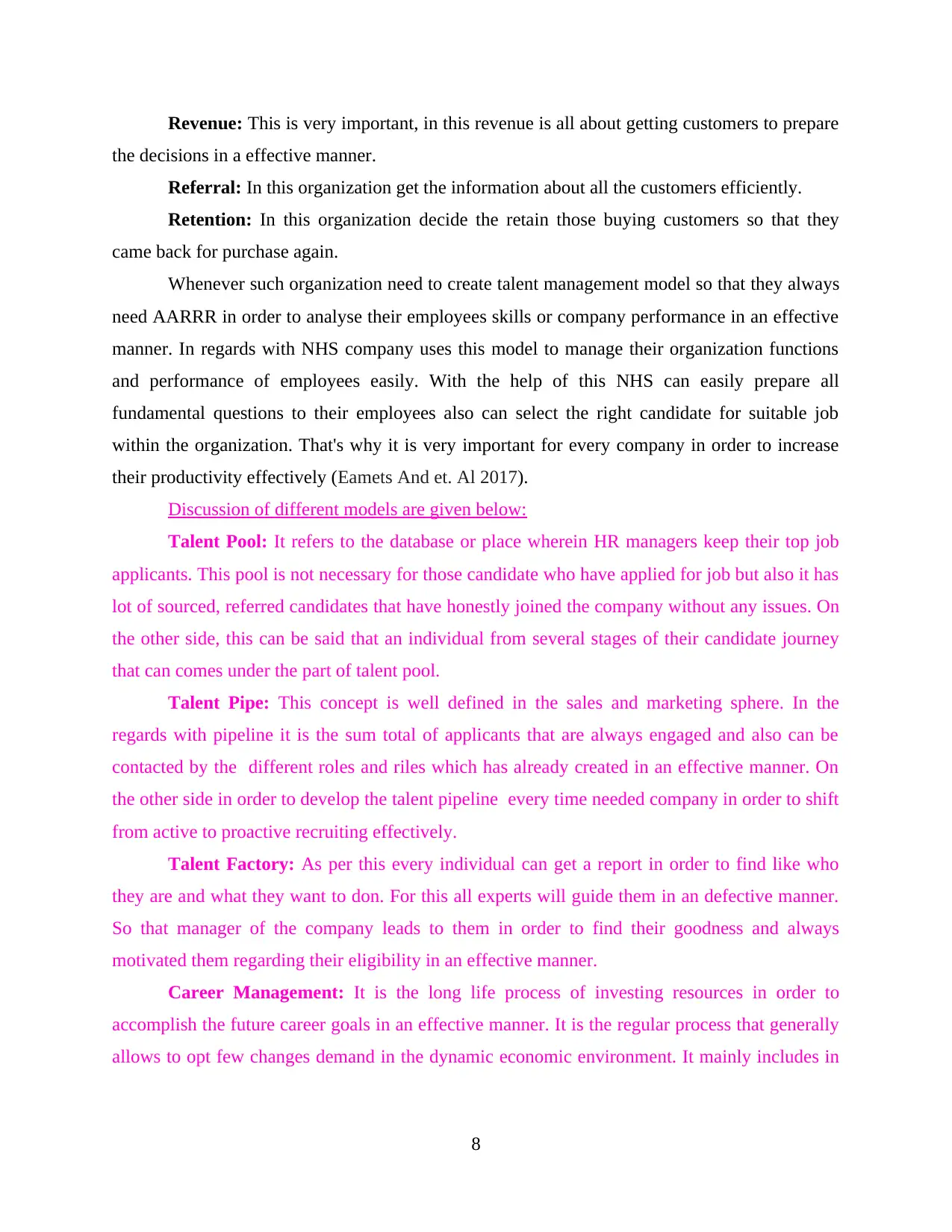
Revenue: This is very important, in this revenue is all about getting customers to prepare
the decisions in a effective manner.
Referral: In this organization get the information about all the customers efficiently.
Retention: In this organization decide the retain those buying customers so that they
came back for purchase again.
Whenever such organization need to create talent management model so that they always
need AARRR in order to analyse their employees skills or company performance in an effective
manner. In regards with NHS company uses this model to manage their organization functions
and performance of employees easily. With the help of this NHS can easily prepare all
fundamental questions to their employees also can select the right candidate for suitable job
within the organization. That's why it is very important for every company in order to increase
their productivity effectively (Eamets And et. Al 2017).
Discussion of different models are given below:
Talent Pool: It refers to the database or place wherein HR managers keep their top job
applicants. This pool is not necessary for those candidate who have applied for job but also it has
lot of sourced, referred candidates that have honestly joined the company without any issues. On
the other side, this can be said that an individual from several stages of their candidate journey
that can comes under the part of talent pool.
Talent Pipe: This concept is well defined in the sales and marketing sphere. In the
regards with pipeline it is the sum total of applicants that are always engaged and also can be
contacted by the different roles and riles which has already created in an effective manner. On
the other side in order to develop the talent pipeline every time needed company in order to shift
from active to proactive recruiting effectively.
Talent Factory: As per this every individual can get a report in order to find like who
they are and what they want to don. For this all experts will guide them in an defective manner.
So that manager of the company leads to them in order to find their goodness and always
motivated them regarding their eligibility in an effective manner.
Career Management: It is the long life process of investing resources in order to
accomplish the future career goals in an effective manner. It is the regular process that generally
allows to opt few changes demand in the dynamic economic environment. It mainly includes in
8
the decisions in a effective manner.
Referral: In this organization get the information about all the customers efficiently.
Retention: In this organization decide the retain those buying customers so that they
came back for purchase again.
Whenever such organization need to create talent management model so that they always
need AARRR in order to analyse their employees skills or company performance in an effective
manner. In regards with NHS company uses this model to manage their organization functions
and performance of employees easily. With the help of this NHS can easily prepare all
fundamental questions to their employees also can select the right candidate for suitable job
within the organization. That's why it is very important for every company in order to increase
their productivity effectively (Eamets And et. Al 2017).
Discussion of different models are given below:
Talent Pool: It refers to the database or place wherein HR managers keep their top job
applicants. This pool is not necessary for those candidate who have applied for job but also it has
lot of sourced, referred candidates that have honestly joined the company without any issues. On
the other side, this can be said that an individual from several stages of their candidate journey
that can comes under the part of talent pool.
Talent Pipe: This concept is well defined in the sales and marketing sphere. In the
regards with pipeline it is the sum total of applicants that are always engaged and also can be
contacted by the different roles and riles which has already created in an effective manner. On
the other side in order to develop the talent pipeline every time needed company in order to shift
from active to proactive recruiting effectively.
Talent Factory: As per this every individual can get a report in order to find like who
they are and what they want to don. For this all experts will guide them in an defective manner.
So that manager of the company leads to them in order to find their goodness and always
motivated them regarding their eligibility in an effective manner.
Career Management: It is the long life process of investing resources in order to
accomplish the future career goals in an effective manner. It is the regular process that generally
allows to opt few changes demand in the dynamic economic environment. It mainly includes in
8

the self-awareness, career planning and development, career exploration, networking and
learning term to long life.
Succession Management: It is the process that mainly ensures the skilled pools in which
employees are trained or meet to the different strategic objectives in an effective manner. On the
other side it is a unique tool that mainly considered the employees identification who have the
potentiality in order to prepare good things for better future.
All of the above mention different models it has been evaluated that Talent factory model
is a very important aspects in which employees can get higher motivation towards their work. In
reference to the NHS they also apply this model because they find the quality of their employees
in order to encourage them in their selected are efficiently.
Career and Succession planning
Career refers to the procedure which helps an individual in finalising their goals and
objectives of professional life. This planning also includes ways through which overall working
activity could be managed effectively according to the preset goals. On the other hand,
succession planning refers to the process in which company focuses on identifying and creating
new leaders who owns capability of replacing old leaders at the time of their retirement. This
type of planning is helpful for business organisation as they enhances availability of experienced
workforce in the company. This experienced workforce already knows about their roles and
responsibilities and they also knows how they can perform all of them in effective manner. In
context of NHS, it has been evaluated that the healthcare company requires to focus on its career
planing by predetermining their goals and objectives. Along with this, the head nurse of NHS
also needs to focus on bringing more experienced workforce in the hospital so that they could
execute their healthcare responsibilities effectively at hospital. In addition to this, it is also
essential for the top management team of NHS to analyse each and every applicant(nurse) at the
time of recruitment in order to recruit best one among the applicant.
Importance of career and succession planning
Career and succession planning are highly important for every business organisation as
they helps in improving performance of the company. It can be said that succession planning is
considered as the heart of talent management process as it is helpful in identifying key
responsibilities and role of the employees so that they can work effectively in the company.
Along with this, it also ensures that the organisation is having appropriate workforce who owns
9
learning term to long life.
Succession Management: It is the process that mainly ensures the skilled pools in which
employees are trained or meet to the different strategic objectives in an effective manner. On the
other side it is a unique tool that mainly considered the employees identification who have the
potentiality in order to prepare good things for better future.
All of the above mention different models it has been evaluated that Talent factory model
is a very important aspects in which employees can get higher motivation towards their work. In
reference to the NHS they also apply this model because they find the quality of their employees
in order to encourage them in their selected are efficiently.
Career and Succession planning
Career refers to the procedure which helps an individual in finalising their goals and
objectives of professional life. This planning also includes ways through which overall working
activity could be managed effectively according to the preset goals. On the other hand,
succession planning refers to the process in which company focuses on identifying and creating
new leaders who owns capability of replacing old leaders at the time of their retirement. This
type of planning is helpful for business organisation as they enhances availability of experienced
workforce in the company. This experienced workforce already knows about their roles and
responsibilities and they also knows how they can perform all of them in effective manner. In
context of NHS, it has been evaluated that the healthcare company requires to focus on its career
planing by predetermining their goals and objectives. Along with this, the head nurse of NHS
also needs to focus on bringing more experienced workforce in the hospital so that they could
execute their healthcare responsibilities effectively at hospital. In addition to this, it is also
essential for the top management team of NHS to analyse each and every applicant(nurse) at the
time of recruitment in order to recruit best one among the applicant.
Importance of career and succession planning
Career and succession planning are highly important for every business organisation as
they helps in improving performance of the company. It can be said that succession planning is
considered as the heart of talent management process as it is helpful in identifying key
responsibilities and role of the employees so that they can work effectively in the company.
Along with this, it also ensures that the organisation is having appropriate workforce who owns
9
⊘ This is a preview!⊘
Do you want full access?
Subscribe today to unlock all pages.

Trusted by 1+ million students worldwide
1 out of 18
Related Documents
Your All-in-One AI-Powered Toolkit for Academic Success.
+13062052269
info@desklib.com
Available 24*7 on WhatsApp / Email
![[object Object]](/_next/static/media/star-bottom.7253800d.svg)
Unlock your academic potential
Copyright © 2020–2025 A2Z Services. All Rights Reserved. Developed and managed by ZUCOL.





